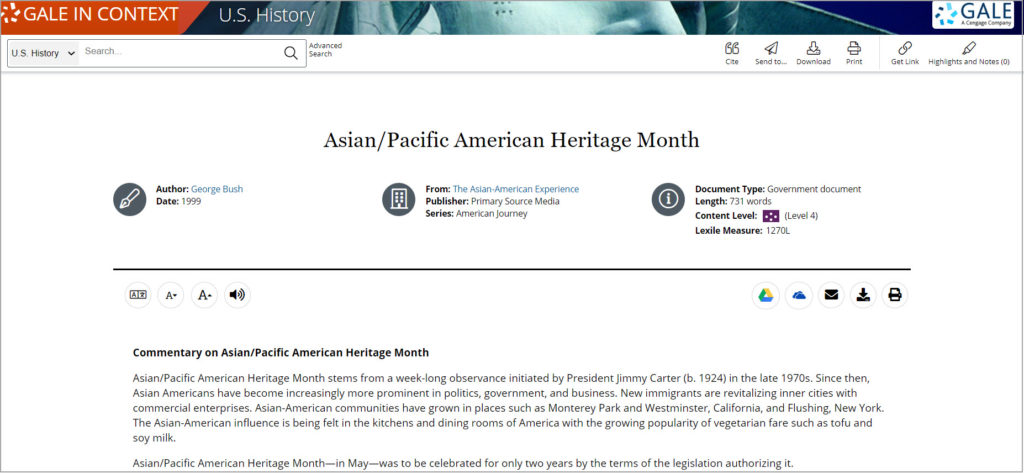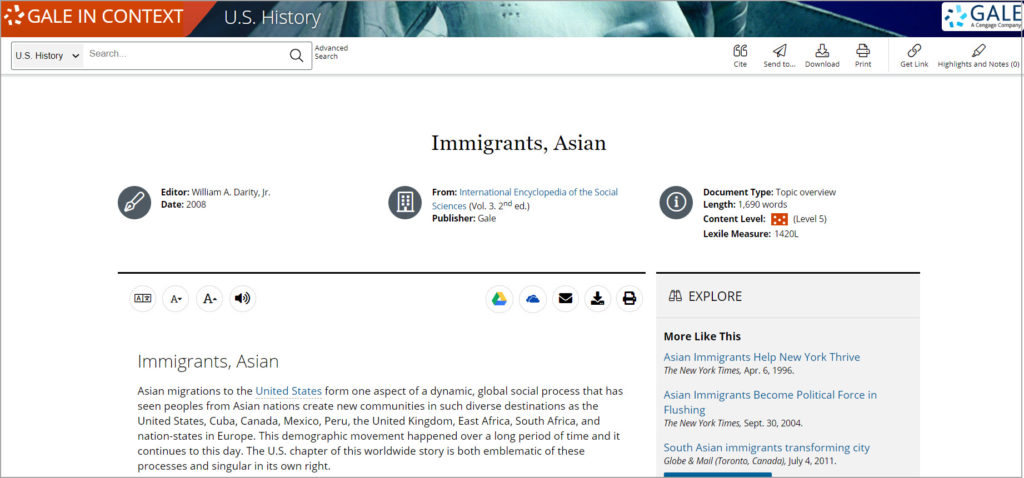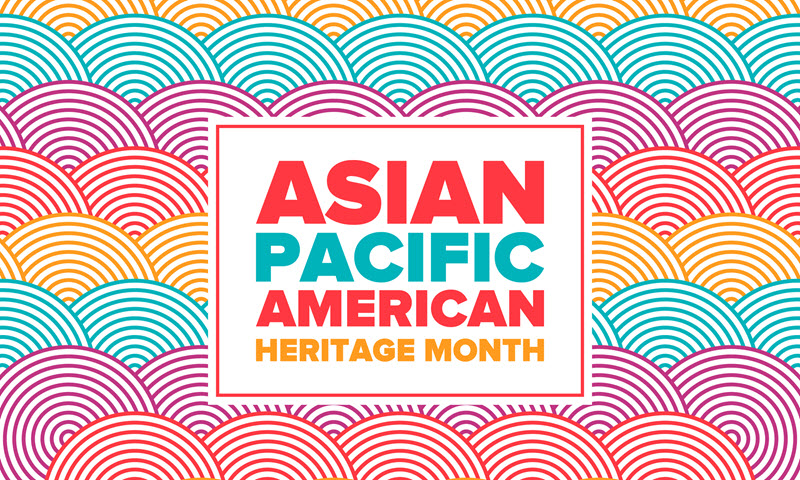| By Tara Atterberry |
1978年美国总统Jimmy Carter在美国总统吉米卡特提供了美国美国人的第一次全国认可。卡特成立了5月10日,作为亚洲/太平洋美国遗产周。This resolution was intended to celebrate two milestones in Asian American and Pacific Islander history: the arrival of the first Japanese immigrants to U.S. soil on May 7, 1843, and the completion of the transcontinental railroad on May 10, 1869, built largely by Chinese workers who had immigrated to the United States in the 1850s and ‘60s.1
President George Bush later expanded this recognition in 1991 by establishing May as Asian/Pacific Islander Heritage Month:2
The Asian/Pacific American heritage is marked by its richness and depth. The world marvels at the wealth of ancient art and philosophy, the fine craftsmanship, and the colorful literature and folklore that have sprung from Asia and the Pacific Islands. Whether they trace their roots to places like Cambodia, Vietnam, Korea, the Philippines, and the Marshall Islands or cherish their identities as natives of Hawaii and Guam, all Asian and Pacific Americans can take pride in this celebration of their heritage.
— George Bush, May 5, 1991

太平洋岛屿的美国人是那些来自太平洋太平洋岛屿地区的人,包括马绍尔群岛,北马里亚纳群岛,帕劳,法属波利尼西亚,汤加,萨摩亚,美国萨摩亚和夏威夷本土人。虽然没有准确地记录,那么到达北美西部海岸的第一个太平洋岛屿都可能是波利尼西亚海洋探险家,在欧洲人在1500年和1600年代到达北美东部沿岸的新世界达到了新世界。3
Thousands of additional Pacific Islanders came under the United States’ umbrella through colonization in the 1800s. The first Pacific Islanders granted legal resident status were French Polynesians in 1843 and individuals from Fiji in 1874, according to the U.S. Department of Homeland Security. Shortly following World War II, individuals from Melanesia and Micronesia immigrated to the United States, followed later by larger numbers of immigrants from Tonga and Samoa in the late 1940s and early 1950s.4美国人口普查局在2000年增加了夏威夷天然夏威夷和其他太平洋岛民的类别。5
The first large waves of Asian immigration into the United States began in the 1840s and ‘50s, as hundreds of thousands of Asian persons, predominately of Chinese descent, immigrated through California’s coast to participate in the gold rush and later to pursue work in California’s growing cities and on the intercontinental railroad. There are estimates that more than 320,000 Chinese immigrated to the United States’ West Coast from 1850 to 1882.6However, Asian immigration to the United States began decades before the 1840s, with smaller numbers of Asians arriving on the East Coast. In 1763, ship workers from the Philippines, referred to as the “Manila men,” were part of the community in what today is Louisiana, while small groups of Asians were working as indentured servants in Pennsylvania and Massachusetts in the 1780s and 1790s, with more than 150 Chinese employed as cooks, sailors, and ship workers in New York by 1856.7

亚洲文化和经济的一个大,各种各样,积极的部门,亚洲和太平洋岛屿遗产的人数超过估计的2500万美国居民。最近,美国人口普查局报告说,2019年美国有超过160万人的太平洋岛民遗产,最大的80多名超过800,000人来自夏威夷或萨摩亚血统。8The 2019 U.S. Census Bureau statistics also assert that there are currently nearly 23 million persons of Asian descent living in the United States. Individuals of Chinese heritage account for the largest percentage of this group, with 8.5 million persons, followed by 4.6 million Asian Indians, 4.2 million Filipinos, 2.2 million Vietnamese, 1.9 million Korean, and 1.5 million Japanese.9
We take the month of May to honor and highlight their backgrounds, contributions, and achievements:10
Time and again throughout our Nation’s history, Asian and Pacific Americans have proved their devotion to the ideals of freedom and democratic government. Those ideals animate and guide our policies toward Asia and the Pacific today. The economic dynamism of the Pacific Rim is a crucial source of growth for the global economy, and the United States will continue working to promote economic cooperation and the expansion of free markets throughout the region. The United States also remains committed to the security of our allies and to the advancement of human rights throughout Asia and the Pacific. We proudly unite in observing Asian/Pacific American Heritage Month。
- 1991年5月6日的乔治布什
金宝搏彩票大风很乐意通过提供各种产品的内容来庆祝亚洲美国和太平洋岛民遗产,为历史,艺术,文化,挑战和实现这一各种群体的历史,艺术,文化,挑战和成就提供内容。请联系大风销售代表,要求试用以下产金宝搏彩票品或许多大风的其他优秀资源:
- 乘客和移民列表索引on the金宝搏彩票Gale目录库。Provides content related to 300 years of Asian and Pacific Islander immigration to the New World.
- Biography and Genealogy Master Indexon the金宝搏彩票Gale目录库。为历史上有超过50,000名亚洲和太平洋岛民提供传记引用。
- Gale In Context: U.S. Historyand金宝搏彩票在背景中的大风:世界历史。在整个历史上,提供详细的参考文章,图像,主要来源,视频,更多,在这组个人的所有方面。
1.美国人口普查2020。“亚裔美国和太平洋岛民遗产月份:5月2021年。” Accessed May 15, 2021.
布什,乔治。“Asian/Pacific American Heritage Month。”亚裔美国人经验。美国旅程。Woodbridge,CT:主要来源媒体,1999。Gale In Context: U.S. History(accessed May 13, 2021).
3. Swain, Liz. “太平洋岛民美国人。” InGale Encyclopedia of Multicultural America, 3rd埃德。,由托马斯里格斯编辑,401-410。卷。3. 金宝搏彩票Gale,2014。Gale In Context: U.S. History(访问5月14日,2021)。
4.见注3。
5.见注3。
6. Benson, Sonia, Daniel E. Brannen, Jr., and Rebecca Valentine. “亚洲移民局。” InUXL Encyclopedia of U.S. History97-104。卷。1.底特律,MI:UXL,2009。Gale In Context: U.S. History(访问5月17日,2021)。
7. “Immigrants, Asian。” In国际社会科学百科全书, 2ndEd。,由威廉A.110编辑,Jr.,562-564。卷。3.底特律,MI:Macmillan参考美国,2008年。Gale In Context: U.S. History(accessed May 13, 2021).
8. See note 1.
9. See note 1.
10.见注释1。

Meet the Author
塔拉特里拉has been with Gale for 26 years and manages biography and genealogy content. She is an avid history and genealogy buff and, when not digging through biographies and historical documents, enjoys scrapbooking; going to estate sales; and spending time with her family, friends, and three cats.

